The Versatile 16x20 Double Mat with 11x14 Opening
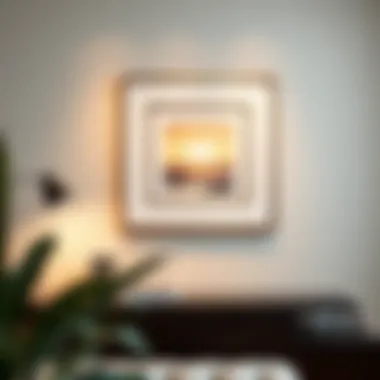
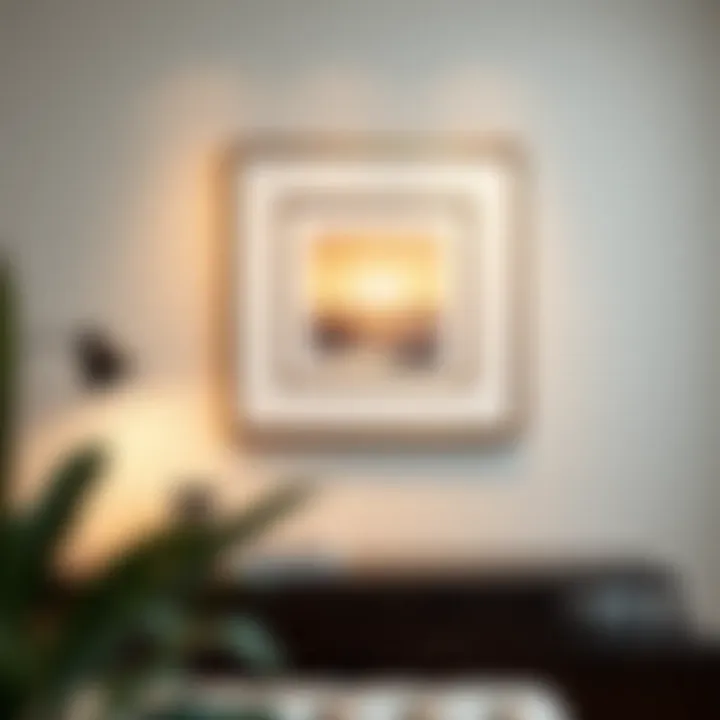
Intro
The world of art and photography framing is rich with choices, and one option that stands out is the 16x20 double mat featuring an 11x14 opening. This framing solution is not just about holding a picture in place; it's about creating a visual narrative. The double mat offers depth, color contrast, and careful border framing that can elevate the presentation of any artwork or photograph. In this guide, we will navigate through the nuances of this versatile mat, emphasizing its significance in aesthetic presentation and practical use.
Furniture Design Trends
Current Styles and Aesthetics
As homeowners and designers seek to create spaces that tell a story, the importance of thoughtful presentation becomes ever more crucial. Double mats have increasingly become popular, resonating with contemporary design principles. From traditional to minimalist themes, a 16x20 double mat can easily adapt. Think of it as the chameleon of the framing world—one moment enhancing a classic oil painting, and the next showcasing a modern photographic print. The styles range from ornate, vintage looks to sleek, simpler designs that align with today's interiors.
Color Palettes and Materials
Choosing the right colors and materials is fundamental in framing art. Here are some aspects to consider:
- Materials: Common materials range from acid-free paper mats to more durable options like cotton rag mats. A high-quality mat not only enhances the artwork but prevents damage over time.
- Color Palettes: Neutral tones are timeless and work well with almost any piece, but bolder colors can make a striking statement, especially against lighter pieces. A deep navy or soft sage can transform a beige wall and create a focal point.
"A well-chosen mat can enrich the story of the artwork it frames, allowing each piece to stand out in its unique way."
Buying Guides
Essential Considerations When Purchasing
When selecting a double mat, it's essential to contemplate various factors:
- Artwork Size: The mat size should complement the piece; the 11x14 opening allows for a standard photo size while the 16x20 overall size offers adequate border space.
- Thickness: Thicker mats can provide deeper visual depth, making artwork appear more substantial.
- Acidity Levels: Opt for acid-free materials to ensure longevity and to protect your art from fading.
Top Recommendations for Different Budgets
Whether you're a DIY enthusiast or a seasoned designer, there are options across the price spectrum. Here are a few:
- Budget-Friendly: IKEA offers a variety of affordable matting options that can cater to basic needs without sacrificing aesthetic quality.
- Mid-Range: Matboard Master is well-known for its quality and gets much love from homeowners looking for sturdiness without breaking the bank.
- Premium Choices: For those willing to splurge, Custom Matboards offers tailored mats that can be designed to complement specific pieces, perfect for galleries or high-stake displays.
In summary, a 16x20 double mat with an 11x14 opening serves as a practical and stylish framing solution. Its versatility extends beyond mere aesthetics, allowing art to breathe while maintaining its integrity. Remember, the right choice can enhance not only the artwork but the overall ambiance of your space.
Understanding the 16x20 Double Mat
When we talk about framing art or photos, the 16x20 double mat with an 11x14 opening isn’t just a decorative accessory; it’s a tangible way to enhance the presentation of cherished memories or impressive artwork. These mats serve not only to highlight the artwork but also to protect it from the ravages of time. Choosing the right mat can elevate the overall aesthetic appeal and influence the viewer's experience.
The size measurement of 16x20 gives you a robust frame that can accommodate various artwork types, while the 11x14 opening allows art or photos of that specific size to fit remarkably well. This specific combination is variegated enough to suit many styles, whether you prefer a minimalist look or something a bit more ornate.
Mats aid in creating visual breathing room between the artwork and its frame, providing clarity and focus to what’s inside. The double mat creates that layered aspect, adding depth and complexity to your display. Not only do double mats serve aesthetic purposes, they also offer practical benefits; they can prevent the art from touching the glass, thereby minimizing the risk of moisture and dust that could damage it.
Another vital aspect is the versatility afforded by a double mat, as it allows for experimentation with colors, textures, and patterns. This contributes to a more dynamic visual narrative, drawing the viewer’s eye and inviting them to explore the artwork more closely. Understanding the 16x20 double mat is foundational in the journey of selecting the perfect frame for your pieces—it's an undercurrent that influences how your art stands out in any space.
Definition and Dimensions
A 16x20 double mat signifies a mat that measures 16 inches by 20 inches, featuring a cut-out opening for an 11x14 piece of artwork or photograph. The double aspect refers to the use of two layers of mats, which can be cut in various sizes and colors to create striking visual contrasts or harmonies. The 11x14 opening is particularly useful because it is a common size for prints and photographs, making it a practical choice for many frames.
Types of Mats Available
When diving into the realm of mats, there are variations that cater to diverse needs.
Single vs. Double Mat
The distinction between single and double mat choices hinges on depth and visual complexity. A single mat consists of one layer, often simpler in design and cost-effective, yet it lacks the layered dimension that can animate a piece. In contrast, a double mat adds depth and a sense of surprise to the framed piece. This multi-layer approach can bridge two colors together, creating an elegant transition and elevating the overall look, which is invaluable for those looking to make a statement with their artwork.
One unique characteristic of the double mat is its ability to subtly influence how colors and textures are perceived, an advantage greatly appreciated by homeowners, designers, and DIY enthusiasts alike.
Pre-Cut vs. Custom Mats
When choosing mats, you often face a choice between pre-cut and custom mats. Pre-cut mats come in standard sizes and are readily available at arts and crafts stores, offering convenience and practicality for those who need a quick solution. They generally have a consistent look, which can be great for projects that require uniformity.
On the other hand, custom mats permit a tailored approach. They can be crafted in any size, color, or texture you desire, making them a fitting option for unique pieces or specific design goals. This offers immense flexibility, allowing for choices that can complement the essence of a particular artwork or photograph.
Historical Context
The history of matting goes hand in hand with the evolution of framing arts. Mats have roots traced back to the late 19th century, evolving from simple pieces to the elaborate designs we see today. Originally serving utilitarian purposes, they have transformed into vital components in the way art is presented, appreciated, and preserved. As framing became a recognized art form, the mat's importance grew. Today, with the advent of technology and printing, the capability to produce high-quality, custom mats has made it possible for anyone to frame like a professional.
The Aesthetic Appeal of Double Mats
The 16x20 double mat with an 11x14 opening is not just a functional tool for framing; it’s a statement piece that can significantly enhance the aesthetic appeal of any artwork or photograph. When you consider how a mat interacts with the piece it surrounds, you realize it does more than provide a border; it sets a tone, impacts perception, and draws the viewer’s eye in an intentional way.
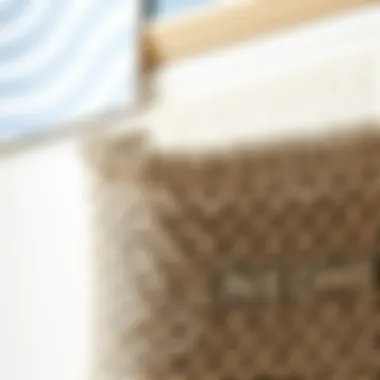
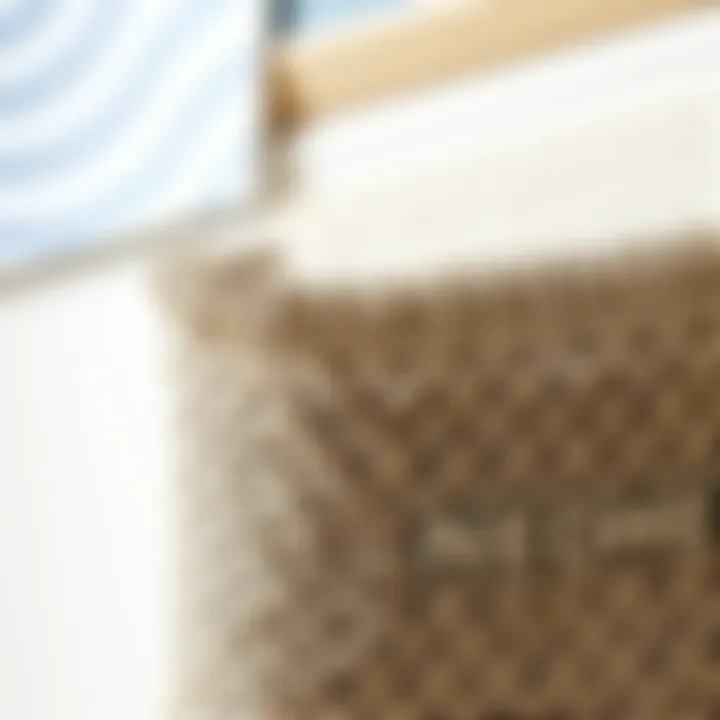
It's not only about what’s contained within the frame but also about how that containment is visually perceived. A well-chosen double mat can add layers of depth and character, making the displayed piece more compelling. Let's explore several critical elements that contribute to the aesthetic prowess of double mats.
Color Choices and Combinations
The colors you choose for a double mat can alter the mood entirely. Color combinations can elevate the artwork while tying together themes within the decor of a room.
Complementary Colors
Using complementary colors is a classic choice when creating visual impact. These are colors opposite each other on the color wheel, like blue and orange or red and green. What they do so effortlessly is create a striking contrast that draws the eye. For instance, if you have a vibrant sunset photograph, a complementary blue mat could enhance the oranges and reds in the image, making those colors pop even more.
This choice can be beneficial because it often results in a dynamic presentation, but it’s not without its challenges. If complementary colors are not well-balanced, they can create a jarring effect. Choosing the right shades and tones to complement rather than clash is crucial.
Contrasting Palettes
On the other side of the spectrum are contrasting palettes, which can serve a very different purpose. While complementary colors create energy, contrasting palettes—combinations that differ in hue and intensity—can provide sophistication. For example, a soft pastel artwork framed with a rich, dark border can create intrigue, enhancing the overall grace of the display.
This choice is increasingly popular for interior decor, as it can subtly anchor a room’s design without overwhelming it. However, one must be careful not to go overboard; too much contrast can result in a chaotic look, which distracts from the art itself.
Texture and Finish
Texture and finish contribute significantly to how a mat interacts visually and literally with both the artwork and the surrounding environment.
Matte vs. Glossy
Matte finishes have gained favor for their subtle charm. They diffuse light, which prevents glare and encourages long viewing sessions without distraction. Glossy finishes, however, can bring a sort of shine that appeals to modern styles, making colors look more vivid. Many prefer matte for fine art pieces, while glossy finds its place with photographic prints.
The unique aspect of matte is its ability to absorb uneeded reflections, whereas glossy surfaces can enhance detail through light play but may require careful positioning to avoid glare.
Fabric vs. Board
When it comes to the material choice, fabric mats can inject warmth and luxury into a framing project. They are often soft to the touch and add an organic feel to the presentation. On the flip side, board mats tend to be more common due to their versatility and vibrant color options. Fabric can elevate sophisticated presentations, yet maintenance can become an issue, as fabrics may attract dust and moisture over time.
Enhancing Visual Interest
Engaging the viewer in an artwork or photograph isn’t just about color and material; it’s also influenced by presentation styles, like layering and border sizes.
Layered Presentation
A layered presentation not only creates a three-dimensional feel but can also highlight various elements of the piece. Adding multiple layers with different colors or textures can guide the viewer’s gaze and increase engagement. It allows for personalization that can give voice to the uniqueness of the displayed art.
However, layering must be approached judiciously, as excessive layers can clutter the presentation, detracting from the artwork instead of enhancing it.
Border Sizes
Border sizes play a pivotal role in framing; they can either amplify or overshadow the artwork within. Wider borders typically are associated with more significant pieces, providing a feeling of importance, while thinner borders can yield a more modern, sleek appearance. This choice often boils down to proportion; making sure the artwork isn't drowned out by an oversized mat will go a long way towards achieving that balanced look.
Ultimately, understanding the aesthetic appeal of double mats is key for homeowners, designers, and DIY enthusiasts alike, as it directly contributes to how an art piece is perceived and appreciated.
Practical Uses of a 16x20 Double Mat
When it comes to framing options, a 16x20 double mat with an 11x14 opening goes beyond mere aesthetics. It's about the practicality that this combination brings to various types of displays. Double mats serve as a buffer, enhancing the visual appeal while protecting the artwork inside it. In this section, we will explore several practical applications of this specific mat size, from framing cherished photographs to showcasing artwork in galleries, and even displaying items in retail environments.
Framing Photographs
Framing photographs is one of the most straightforward yet significant uses of a double mat. It transforms simple snapshots into elegant displays that capture memories for a lifetime.
Family Portraits
When it comes to family portraits, the emotional weight they carry can’t be overstated. A family portrait isn’t just an image; it’s a cherished memory. The particular quality of family portraits lies in their capacity to capture shared moments — the essence of family captured in one frame. Utilizing a 16x20 double mat not only elevates the photograph itself but also allows for visual breathing space around the image. This is essential; viewers experience a sort of psychological distance which creates a more captivating encounter.
Additionally, using a double mat in this context serves a crucial purpose: it protects the photograph from environmental damage. The recommended materials are acid-free, which prevents yellowing over time and can be customized to suit the family’s style, making it a versatile choice for anyone looking to preserve treasured moments.
Travel Memories
Travel memories capture the essence of adventure and exploration, creating a visual diary of experiences that one can reminisce about. A 16x20 double mat can serve as a stage for these snapshots, emphasizing the vibrant colors and cultural richness inherent in travel photography. People often circle back to these memories, and framing them in a double mat gives them prominence in home decor.
The unique aspect of travel photographs is that they often invoke powerful feelings. By using a double mat, you're not just protecting the photo; you're also spotlighting it in a way that speaks to the experiences behind the lens. However, it's important to consider the type of mat colors when framing and choose shades that complement the tones in the photos.
Showcasing Artwork
The versatility of a double mat extends well into the realm of artwork. Artists and collectors alike can utilize this framing method to present their pieces effectively.
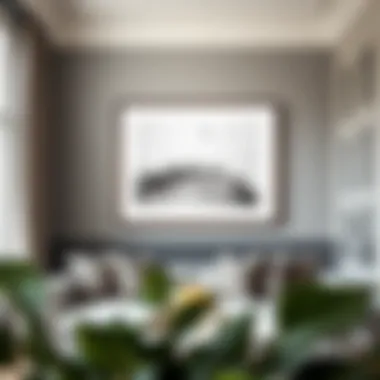
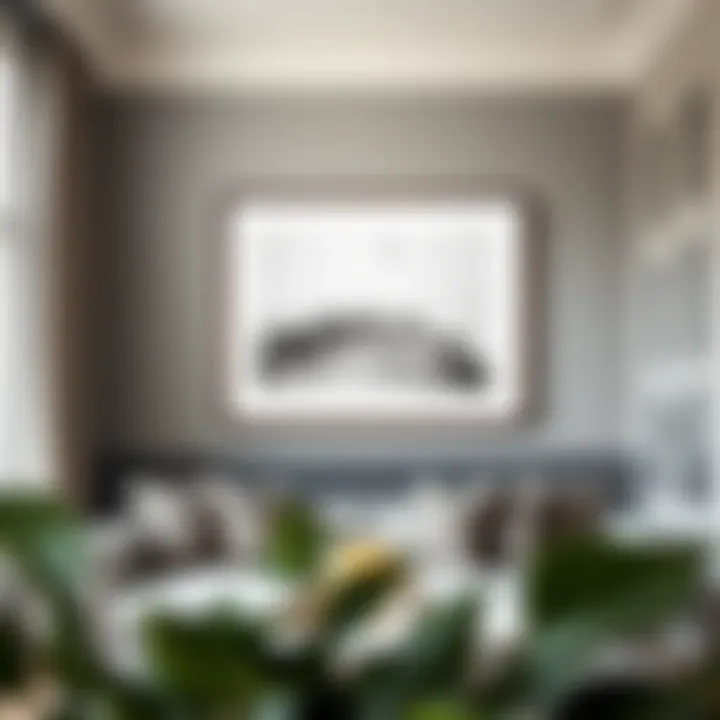
Paintings
When framing paintings, one crucial facet is how a mat can enhance the painting's colors and textures. Using a 16x20 double mat can create a stunning layered effect that draws the viewer's eye. This is particularly beneficial in larger works, where the mat acts as a framework that prevents the viewer from feeling overwhelmed by the canvas.
A unique feature of double mats for paintings is that they allow for varying thicknesses of the border, accommodating different artistic styles. This can create an impactful visual statement. However, an important consideration is that heavier frames might distract from delicate pieces, requiring a careful selection process.
Prints and Posters
Prints and posters, whether they be of famous artworks or personal designs, hold an important place in many homes. The right double mat elevates these prints from mere posters to substantial pieces of decor. A 16x20 double mat with an 11x14 opening creates a professional look while maintaining a level of informality that can fit seamlessly into any room.
Additionally, since prints can often be lighter and less fragile than paintings, the use of a double mat helps to add a layer of protection while also providing flexibility in terms of design. A clear advantage here is the opportunity to mix and match colors and textures without overwhelming the aesthetic impact.
Display in Retail and Exhibitions
The application of double mats extends succinctly into retail and exhibition displays. In such settings, it’s all about attracting attention and creating memorable interactions. A well-framed piece can stop customers in their tracks, inviting them to take a closer look.
When utilized in shops, a double mat can help to elevate promotional materials, making themappear significant and dependable. This is especially true in galleries where art must be presented professionally yet invitingly. A good framing choice is pivotal in communicating the value of the displayed works, and a double mat serves as an effective medium to achieve that.
"First impressions count. In retail, your display must speak volumes."
Selecting the Right Double Mat
When it comes to framing art or photographs, the selection of a double mat plays an essential role in not just the aesthetics but also the overall presentation and protection of the piece. Choosing a suitable double mat can affect the durability of the artwork as well as how it interacts with the surrounding decor. Let's dive deeper into the crucial elements of selecting the right double mat, exploring material choices, sizes, and how personalization can elevate your display.
Material Considerations
Acid-Free Options
Acid-free double mats are a critical element in the preservation of images and artwork. The key characteristic of acid-free materials is their ability to resist yellowing and deterioration over time. This is particularly beneficial when framing precious photographs or artwork, ensuring they remain in their original condition for years to come. Acid-free mats are specially treated to neutralize acid levels, providing a safe environment for your cherished pieces.
One unique feature of acid-free options is their extensive variety in colors and textures, allowing for both aesthetic appeal and conservation. The downside? They might come at a slightly higher price point than standard mats, but many would argue that the long-term benefits outweigh the initial costs.
Eco-Friendly Materials
In recent times, environmentally-conscious choices have crept into the world of framing too. Eco-friendly materials, often made from recycled products or sustainably sourced fibers, not only contribute to the well-being of the planet but also resonate with those who prioritize sustainability in their home decor. The main characteristic of these materials is their non-toxic processing, which ensures a safer choice for both artworks and the space around them.
However, finding eco-friendly mats can occasionally limit your options in terms of colors and finishes. Nevertheless, as this segment of the market expands, more creative designs are popping up to meet varying tastes and styles.
Size and Fit
Choosing the Right Opening Size
Selecting the appropriate opening size is essential in creating a balanced frame for your artwork. The right opening ensures that the focal point is centered and appropriately highlighted within the dimensions of the double mat. The distinguishing feature here is the standard 11x14 opening which is common and versatile, fitting a variety of artworks.
A notable advantage of choosing the right opening size is that it enhances proportion. An ill-fitting mat can overshadow the artwork itself or leave too much empty space, creating an unappealing appearance. Thus, attention to the opening size can really transform how a piece is experienced.
Calculating Border Sizes
Calculating the border sizes adds another layer of depth when framing with a double mat. The border can be adjusted based on personal preference or to complement the size and dimensions of the artwork. The key here is related directly to the visual weight of the piece being framed; a larger piece may benefit from a thicker border while smaller images can look more cohesive with a finer edge.
The unique feature of this calculation process is that it allows you to control the overall visual impact of the framed art. A disadvantage could be the potential for overthinking, as the fine line between bold and overwhelming can sometimes be delicate. Ultimately though, attentive calculations lead to a more refined presentation.
Personalization and Customization
Unique Designs
One of the most exciting aspects of selecting a double mat is the opportunity for unique designs. Customizable options allow individuals to reflect their personality through creativity. Whether it’s an unusual color combo or patterned mats that catch the eye, personalized designs add character and flair to any display.
The clear advantage of this flexibility is that it turns a simple framed piece into a statement of style and individuality. customers can corral a distinctive look that vividly represents their tastes. However, a possible downside is that over-customization can sometimes render the mat too thematic or matchy, which could detract from the art itself.
Engraving and Embellishments
Lastly, adding engravings or embellishments is another way to make your double mat truly one-of-a-kind. It’s not just about aesthetics; personalized inscriptions can memorialize dates, quotes, or names that are significant to the viewer.
This practice creates not just visual interest but emotional connection to the piece, elevating its value beyond mere decor. Nevertheless, potential over-embellishment might overshadow the artwork, so it's crucial to strike the right balance to maintain focus on what matters most—the art itself.
Caring for Your Double Mat
Caring for your double mat is essential to maintain its aesthetic and protective qualities over time. With the right approach, you can prolong its lifespan and keep your artwork looking just as vibrant as the day it was framed. Proper care ensures that the mat does not lose its form or color, which can detract from the beauty of the pieces it's meant to enhance. This section outlines best practices for maintaining, storing, and ensuring your double mat withstands the test of time.
Best Practices for Maintenance


Cleaning Techniques
Cleaning your double mat may seem like a tedious task, but it's vital for preserving its appearance. Using an acid-free cloth or soft brush to gently remove dust can work wonders for keeping the mat looking fresh.
- Key characteristic: Gentle yet effective, these techniques do not damage the mat surface.
- Unique feature: By using brushes made for delicate surfaces, you can avoid scratching its finish.
- Advantages: It allows the mat to remain visually appealing, enhancing the overall presentation of your framed art.
However, be cautious not to use any wet substances directly on the mat, as moisture can cause warping or staining.
Avoiding Environmental Damage
Environmental factors can play a major role in damaging your double mat. To protect it, consider mounting it in a location away from direct sunlight, as prolonged exposure can lead to fading.
- Key characteristic: Provides a barrier against UV rays, which can deteriorate both the mat and the artwork.
- Unique feature: By using protective glass in framing, you can further guard against dust and humidity.
- Advantages: This care extends the life of your mat and artwork, maintaining their visual integrity.
Storage Considerations
Acid-Free Storage Solutions
When it comes to storing your double mat, acid-free solutions are a must. Storing it flat in a protective sleeve or box can prevent bending and creasing.
- Key characteristic: Preventing acid damage is crucial, as it can degrade both the mat and the artwork.
- Unique feature: Acid-free materials assure longevity, making it more suitable for precious pieces.
- Advantages: This method not only protects the mat but allows for easy access when needed.
Humidity Control
Humidity can be a silent enemy to paper products. Maintaining a controlled environment is vital to the care regimen for your double mat.
- Key characteristic: It prevents moisture from causing warping or mold growth, which is particularly critical if your art features photographs or certain types of paper.
- Unique feature: Employing silica gel packs in storage can help absorb excess moisture.
- Advantages: This ensures a stable environment for your mat, reducing the risk of damage from fluctuating humidity levels.
"Keeping things in great condition is all about the little details that go a long way."
For more detailed information on care techniques and framing tips, consider reading articles from The Spruce Crafts or visiting Wikipedia.
Current Trends in Framing with Double Mats
The world of framing is ever-evolving, reflecting shifts in aesthetic preferences, sustainability concerns, and practical applications. In recent years, the 16x20 double mat featuring an 11x14 opening has emerged as a prominent choice for homeowners and designers alike. This space serves not only to highlight artwork but also to elevate the overall presentation of photographs or prints. By understanding current trends, you can make informed decisions that resonate with both your aesthetic choices and functional needs.
Minimalism and Simplicity
Often less is more, especially in the context of interior design. The minimalist approach has gained traction, emphasizing clean lines and simplicity to create a sense of calm and order. In framing, this trend translates into the use of neutral colors and understated mats that do not overpower the artwork. The 16x20 double mat, with its 11x14 opening, fits perfectly into these minimalist themes. It creates a simple yet elegant presentation that accentuates the main piece without distraction.
Notably, using a monochromatic double mat can enhance the elegance of framed pieces. When limited to shades of black, white, or gray, the overall look remains sophisticated while ensuring that the artwork is the star of the show. Homeowners seeking to create an airy feel are now often choosing these understated options when showcasing family portraits or travel photographs.
Eclectic Styles and Layering
On the flip side, eclectic styles are making waves as individuals express their unique personalities through their decor. Layering different textures and colors, including the use of patterned double mats, can add depth to framed artworks. This trend encourages mixing various styles—from vintage frames to modern designs—resulting in a captivating visual narrative.
Layering also introduces the playful aspect of framing. By using a 16x20 double mat with a bold pattern or a vibrant color as a background, the artwork takes on a new dimension. Combining various matting styles, whether it be through different colors or textures, enhances the display, inviting viewers to explore the juxtaposition of old and new within a single frame.
Sustainable Practices in Framing
Sustainability is not just a fad; it's becoming a primary concern for many consumers. The push for eco-friendly materials has seeped into the framing world, influencing choices around double mats. Contemporary consumers are leaning towards acid-free, recycled, or sustainably sourced materials, aligning their aesthetic choices with ethical values.
When selecting a double mat, buyers can look for those certified by reputable agencies that signify environmentally conscious practices. It’s critical to consider how materials impact not only the artwork but the environment. Choosing the right 16x20 double mat that meets sustainability standards can play a role in minimizing your carbon footprint, ensuring your creative expressions do not come at the earth's expense.
Utilizing this knowledge empowers both homeowners and designers to foster a beautiful and sustainable living environment while still showcasing their personalities wonderfully. As the trends shift, so too should our approach to framing, making sure it’s aligned with our collective values while nurturing our individual tastes.
Final Thoughts on Choosing a Double Mat
Selecting the right double mat is an integral part of showcasing your cherished photographs and artworks. The 16x20 double mat with an 11x14 opening not only elevates the visual appeal of your pieces but also serves several functional purposes. This choice becomes akin to the frame for a vibrant painting—it surrounds it, enhances it, and presents it in the best light. A thoughtful selection process can contribute to a well-organized space.
Evaluating Personal Needs vs. Aesthetic Preferences
When it comes to picking a double mat, it’s essential to start by looking into your personal needs. Consider if you are looking for mats just for home decorations or perhaps for an exhibit. For homeowners, a mat should reflect your style, fitting into the larger decor of your living space. Designers might prioritize different aspects, perhaps looking for unique textures or colors that stand out in a professional portfolio.
- List your photos or art pieces that you intend to frame.
- Think about the existing colors and themes in your home.
- Make a note of any prominent colors or artworks that can guide you.
Then, balance your personal needs with your aesthetic preferences. Some people may prefer a minimalist approach, while others dive headfirst into complexity. For instance, if you have a vibrant painting, a subtler mat might allow the artwork to take center stage. Conversely, if the mat itself has personality, it might become the statement piece.
Balancing Functionality with Style
Choosing a double mat is not just about beauty; functionality matters just as much. The 16x20 mat, for example, offers ample space for an 11x14 image, providing a visually appealing border that draws attention to the art. It is this balance which elevates the framing experience from basic to exceptional.
- Consider how often you will be changing the artwork or photographs.
- Think about the material's longevity. Acid-free options are best if you’re looking for preservation.
A well-chosen mat can protect your works from dust and deterioration, keeping them looking fresh over time. However, don’t sacrifice style for utility. You can find materials that offer both durability and design flair. Techniques like layering can bring out the fun elements while ensuring the mat suits practical needs.
"A mat should be both a guardian and a highlighting partner to the artwork it frames."
Understanding these various elements will bring clarity, helping you make informed choices that resonate with both your sensibilities and the universal aesthetics of framing. In the end, finding that sweet spot between your needs, preferences, and functionality will render your artworks and photos not only seen, but admired.















